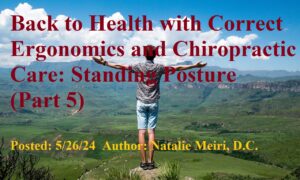
Back to Health with Correct Ergonomics and Chiropractic Care: (Standing Posture) Part 5 is about how to make changes in your daily life for better posture and health. So posture is the way that you hold your body at any given moment, whether sitting, standing, or being active. And ergonomics is a science dedicated to studying human posture that is the most healthy for our bodies.
Many patients seek chiropractic care for pain relief, but your chiropractor should also help you decide which aggravating activities are unnecessary and must be eliminated. This is important for prevention of rein-jury and for further future trauma. Get started with some facts in our latest post.
Back to Health with Correct Ergonomics and Chiropractic Care: Standing Posture (Part 5)- Standing/Upright Posture
Round – shouldered posture is an important mechanical activating and perpetuating factor for the myofascial pain cycle. Continued round shouldered posture causes adaptive shortening of muscles in the area leading to pain and dysfunction.
These syndromes can cause arm pain and weakness. Indeed, there is a significance in that what happens in a certain part of the body effects another part. Furthermore, it is crucial to remember that everything is connected. What happens from the feet up to the head position influences your body. Moreover, whether you are standing or sitting this is occurring. Your feet and your pelvis are crucial support structures, but so are all the other body structures.
“Think Tall”
One simple technique you can do to develop good posture and movement is to “think tall”. Go ahead and lengthen yourself. Move your head upward in relation to your body (away from your body, making yourself taller). Then your body will follow and come into good alignment. Of course it is not practical for a person to perform this slight movement every minute of the day. Nevertheless, the more often the movement is performed, with every daily movement activity, the easier it becomes. Matthias Alexander deserves credit for his principle of movement that uses the conscious mind to change subconscious muscle patterns.
Relaxation
For relaxation in the sitting position, a well designed chair with adequate lumbar support and the correct height armrests is necessary. When standing or walking, you should focus on the floor under the feet, trying to feel the texture and hardness of the carpet, flooring, or concrete with each step. Unnecessary muscles tension is relieved by this. Similarly, while resting, sensation should be concentrated on the bed that supports the body, on the texture/softness of the sheets, and on the shape of the supporting surface. In conclusion, this concentration on the underlying support beneath the body encourages relaxation.

Muscle relaxation
Firstly, muscles relax more fully immediately following a gentle contraction. Secondly, when lying down and trying to relax, you can feel the difference in muscle tension. Thirdly, before and after the contraction of individual muscle groups you can feel change. Fourthly, interestingly, relaxation is an active process that requires intense concentration. Fifthly, this concentration on relaxation helps to clear the mind for sleep.
Lastly, training in biofeedback and mind management, such as meditation, can help people learn how to relax their muscles. Additionally, during exercise, a pause for several deep breaths greatly aids muscular relaxation between cycles. This permits time for return of circulation, helps you to reduce chronic tension of the muscles and perform your exercise with better form.

Your chiropractor is your partner in your healthcare.
At Meiri Chiropractic in West Palm Beach, we’ll work with you to get the relief and health you need through chiropractic care. Together, we can be on the lookout for life and work situations where you experience pain in relation with poor posture. Pain is our body’s way of warning us of problems, so don’t ignore it. Shape up your life! Check your posture today.📞Contact Meiri Chiropractic today at 561-253-8984 to make an appointment or to learn more about Back to Health with Correct Ergonomics and Chiropractic Care: Standing Posture (Part 5).